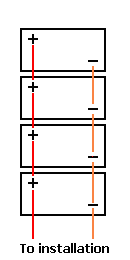I am posting this as its own thread, though it came up in another I posted here. It is a stand-alone topic.
I need about a 710 Ah 48V battery bank. I located a 375 Ah 6V battery, and was planning to create a 750 Ah bank with 2 strings of 8 batteries in parallel. Sixteen for $5600. I had seen advice to never use more than 3 strings in parallel.
A user here suggested I use a single string of batteries, since parallel strings can cause problems. With research, I found examples of people who said "I will never parallel batteries again". One novel description said the issues with paralleling increase with the number of strings as:
Issues = (# strings)^^2
OK, I looked and found some 2V cells. One (Crown 2CRP1100) was around $900 per battery. I stopped looking at this point, since that is $19400 for twenty four.
This leads to a question. Are the disadvantages of two parallel strings so great as to go to a single string? Should I keep looking for 2V cells that are more economical? A gut feeling, not based on fact, is that unless I could get in for a 50% premium (~$8000), it wouldn't be worth it. On the other hand, these 2V cells may last twice as long. Maybe I should be trying to find 24 2V cells for $11,000?
Perhaps someone could address the issues I might face at some point with two strings instead of one.
Thanks!
PS More than once, someone has suggested initially using golf cart or cheaper batteries at first - this question is for a permanent solution.
I need about a 710 Ah 48V battery bank. I located a 375 Ah 6V battery, and was planning to create a 750 Ah bank with 2 strings of 8 batteries in parallel. Sixteen for $5600. I had seen advice to never use more than 3 strings in parallel.
A user here suggested I use a single string of batteries, since parallel strings can cause problems. With research, I found examples of people who said "I will never parallel batteries again". One novel description said the issues with paralleling increase with the number of strings as:
Issues = (# strings)^^2
OK, I looked and found some 2V cells. One (Crown 2CRP1100) was around $900 per battery. I stopped looking at this point, since that is $19400 for twenty four.
This leads to a question. Are the disadvantages of two parallel strings so great as to go to a single string? Should I keep looking for 2V cells that are more economical? A gut feeling, not based on fact, is that unless I could get in for a 50% premium (~$8000), it wouldn't be worth it. On the other hand, these 2V cells may last twice as long. Maybe I should be trying to find 24 2V cells for $11,000?
Perhaps someone could address the issues I might face at some point with two strings instead of one.
Thanks!
PS More than once, someone has suggested initially using golf cart or cheaper batteries at first - this question is for a permanent solution.

Comment